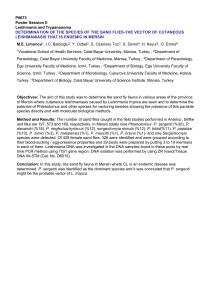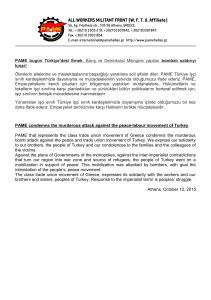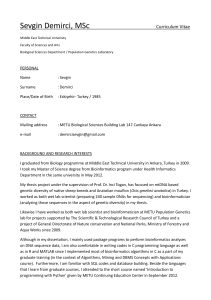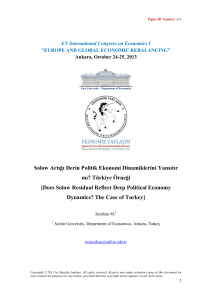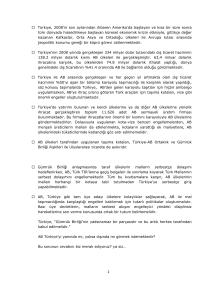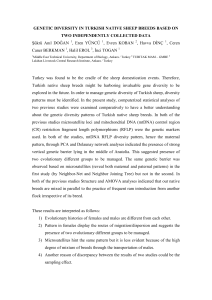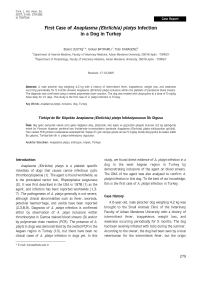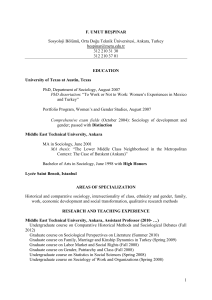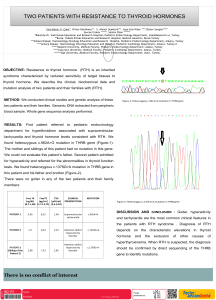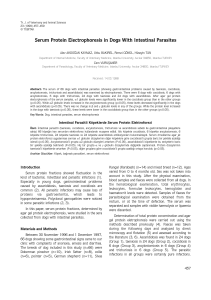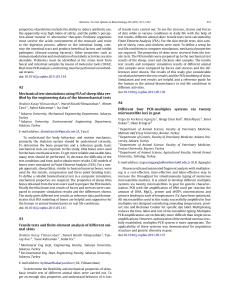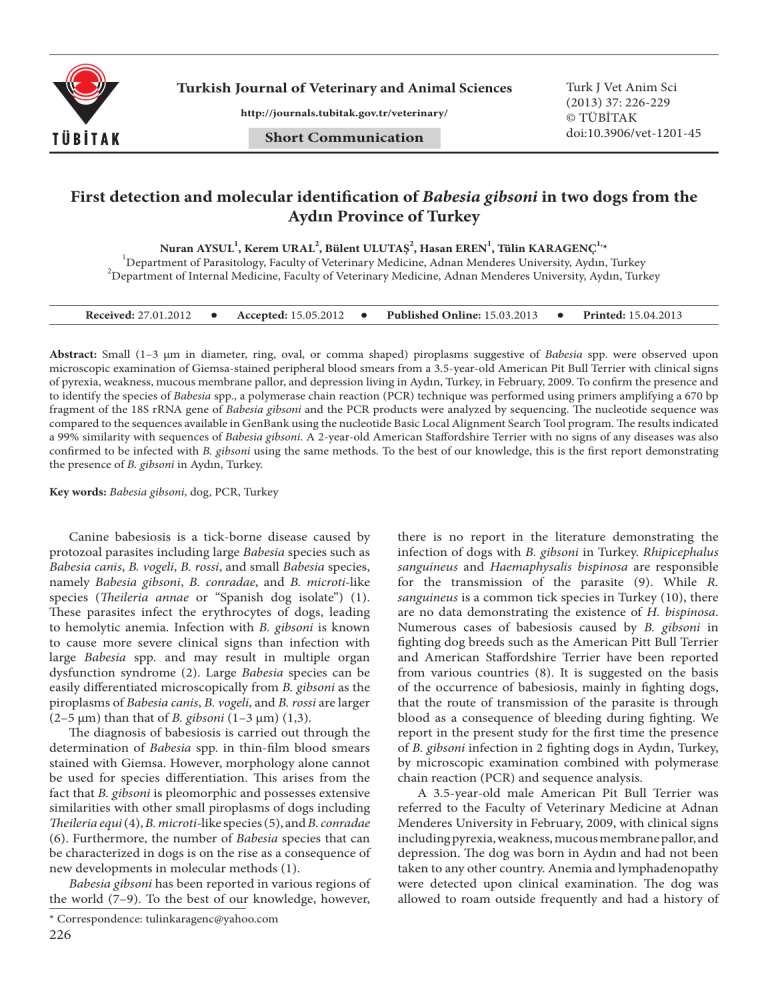
Turkish Journal of Veterinary and Animal Sciences
http://journals.tubitak.gov.tr/veterinary/
Short Communication
Turk J Vet Anim Sci
(2013) 37: 226-229
© TÜBİTAK
doi:10.3906/vet-1201-45
First detection and molecular identification of Babesia gibsoni in two dogs from the
Aydın Province of Turkey
1
2
2
1
1,
Nuran AYSUL , Kerem URAL , Bülent ULUTAŞ , Hasan EREN , Tülin KARAGENÇ *
Department of Parasitology, Faculty of Veterinary Medicine, Adnan Menderes University, Aydın, Turkey
2
Department of Internal Medicine, Faculty of Veterinary Medicine, Adnan Menderes University, Aydın, Turkey
1
Received: 27.01.2012
Accepted: 15.05.2012
Published Online: 15.03.2013
Printed: 15.04.2013
Abstract: Small (1–3 µm in diameter, ring, oval, or comma shaped) piroplasms suggestive of Babesia spp. were observed upon
microscopic examination of Giemsa-stained peripheral blood smears from a 3.5-year-old American Pit Bull Terrier with clinical signs
of pyrexia, weakness, mucous membrane pallor, and depression living in Aydın, Turkey, in February, 2009. To confirm the presence and
to identify the species of Babesia spp., a polymerase chain reaction (PCR) technique was performed using primers amplifying a 670 bp
fragment of the 18S rRNA gene of Babesia gibsoni and the PCR products were analyzed by sequencing. The nucleotide sequence was
compared to the sequences available in GenBank using the nucleotide Basic Local Alignment Search Tool program. The results indicated
a 99% similarity with sequences of Babesia gibsoni. A 2-year-old American Staffordshire Terrier with no signs of any diseases was also
confirmed to be infected with B. gibsoni using the same methods. To the best of our knowledge, this is the first report demonstrating
the presence of B. gibsoni in Aydın, Turkey.
Key words: Babesia gibsoni, dog, PCR, Turkey
Canine babesiosis is a tick-borne disease caused by
protozoal parasites including large Babesia species such as
Babesia canis, B. vogeli, B. rossi, and small Babesia species,
namely Babesia gibsoni, B. conradae, and B. microti-like
species (Theileria annae or “Spanish dog isolate”) (1).
These parasites infect the erythrocytes of dogs, leading
to hemolytic anemia. Infection with B. gibsoni is known
to cause more severe clinical signs than infection with
large Babesia spp. and may result in multiple organ
dysfunction syndrome (2). Large Babesia species can be
easily differentiated microscopically from B. gibsoni as the
piroplasms of Babesia canis, B. vogeli, and B. rossi are larger
(2–5 µm) than that of B. gibsoni (1–3 µm) (1,3).
The diagnosis of babesiosis is carried out through the
determination of Babesia spp. in thin-film blood smears
stained with Giemsa. However, morphology alone cannot
be used for species differentiation. This arises from the
fact that B. gibsoni is pleomorphic and possesses extensive
similarities with other small piroplasms of dogs including
Theileria equi (4), B. microti-like species (5), and B. conradae
(6). Furthermore, the number of Babesia species that can
be characterized in dogs is on the rise as a consequence of
new developments in molecular methods (1).
Babesia gibsoni has been reported in various regions of
the world (7–9). To the best of our knowledge, however,
*Correspondence: tulinkaragenc@yahoo.com
226
there is no report in the literature demonstrating the
infection of dogs with B. gibsoni in Turkey. Rhipicephalus
sanguineus and Haemaphysalis bispinosa are responsible
for the transmission of the parasite (9). While R.
sanguineus is a common tick species in Turkey (10), there
are no data demonstrating the existence of H. bispinosa.
Numerous cases of babesiosis caused by B. gibsoni in
fighting dog breeds such as the American Pitt Bull Terrier
and American Staffordshire Terrier have been reported
from various countries (8). It is suggested on the basis
of the occurrence of babesiosis, mainly in fighting dogs,
that the route of transmission of the parasite is through
blood as a consequence of bleeding during fighting. We
report in the present study for the first time the presence
of B. gibsoni infection in 2 fighting dogs in Aydın, Turkey,
by microscopic examination combined with polymerase
chain reaction (PCR) and sequence analysis.
A 3.5-year-old male American Pit Bull Terrier was
referred to the Faculty of Veterinary Medicine at Adnan
Menderes University in February, 2009, with clinical signs
including pyrexia, weakness, mucous membrane pallor, and
depression. The dog was born in Aydın and had not been
taken to any other country. Anemia and lymphadenopathy
were detected upon clinical examination. The dog was
allowed to roam outside frequently and had a history of
AYSUL et al. / Turk J Vet Anim Sci
1
2
3
4
5
670 bp
Figure 1. Ring, oval, and comma shaped small Babesia parasites
(arrows) detected in thin blood smears.
fighting with stray dogs 3 weeks before admission to the
clinic. According to the owner, the dog was routinely
vaccinated and treated for external and internal parasites
on a regular basis. No ticks were found during the physical
examination. However, splenomegaly was evident on
ultrasonographic examination. Hematological analysis
revealed microcytic-hypochromic anemia (red blood
count, 1.57 × 106/µL; mean cell volume (PCV), 39.2 fL;
mean corpuscular hemoglobin concentration, 29.21%;
hemoglobin, 6.4 g/dL; and packed cell volume, 21.0%),
thrombocytopenia (75 × 109/L), and elevated alanine
transaminase and aspartate aminotransferase levels (98
and 116 IU/L, respectively) in association with hepatic
hypoxia. These parameters suggested that the dog might
have blood parasites, hemolytic anemia, and/or other
relevant infectious diseases. In an attempt to distinguish
between these possibilities, microscopic examination of
Giemsa-stained thin blood smears prepared from the ear
margin was carried out. Ring shaped, oval, and commalike organisms, about 1–3 µm in diameter, were detected
in the erythrocytes (Figure 1). The degree of parasitemia,
calculated as the percentage of infected red blood cells
by counting 1000 red blood cells, was 5.4%. On the basis
of the size of the intracellular parasites observed in this
case, the possibility that the dog might have been infected
with small Babesia spp., especially with B. gibsoni, was
considered. The fact that B. gibsoni cannot be distinguished
from other canine small babesial isolates by microscopy
prompted us to use PCR followed by sequence analysis for
a definitive diagnosis.
DNA from ethylenediaminetetraacetic acid-treated
blood (300 µL) was extracted using the Wizard® Genomic
DNA purification Kit (Promega Corporation, Madison,
WI, USA) according to the manufacturer’s instructions.
A primer set including Gib599F (5′-CTC-GGC-TACTTG-CCT-TGT-C-3′) and Gib1270R (5′-GCC-GAAACT-GAA-ATA-ACG-GC-3′) (Thermo Electron GmbH,
Figure 2. Amplification of the small 18S rRNA gene region
of B. gibsoni with the primers Gib599 and Gib1270 from an
infected dog in Aydın, Turkey. 1: 100 bp molecular marker, 2:
clinically sick dog (American Pit Bull Terrier), 3: the second dog
(American Staffordshire Terrier), 4: negative dog sample, and 5:
negative control (water). The PCR products were run on 1.5%
agarose gel and stained with ethidium bromide.
Germany) was used to amplify a 670 bp fragment of the
18S rRNA gene region specific to B. gibsoni (11). The PCR
mix consisted of 12.5 pmol of each primer, 100 µM of each
dNTP (Roche Diagnostics GmbH, Roche Applied Science,
Germany), 1X PCR reaction buffer, 1.25 U Taq DNA
polymerase (Roche Diagnostic GmbH) and 5 µL DNA
in a final volume of 25 µL. The cycling conditions were as
follows: 95 °C for 5 min, followed by 35 cycles at 95 °C for
30 s, 55 °C for 30 s, 72 °C for 90 s, and a final extension
step of 72 °C for 10 min. A negative sample control (canine
blood DNA only) and a negative DNA control (Milli-Q
water in a substitute of DNA) were included in the PCR
reaction. The PCR products were run on 1.5% agarose
gel and stained with ethidium bromide. The size of the
amplified PCR product was 670 bp (Figure 2). To confirm
the results of the PCR, the PCR product was sent to İontek
(İstanbul, Turkey) for sequence analysis. The nucleotide
sequence was compared with available sequences in
GenBank using the nucleotide Basic Local Alignment
Search Tool program. The analysis indicated that there is a
99% similarity with various sequences of the B. gibsoni 18S
rRNA gene deposited in GenBank (Accession numbers:
AB478330.1, AB478328.1, FJ769388.1, EU084679.1, etc.).
This finding demonstrated that the dog was infected with
B. gibsoni. The sequence of the PCR product was then
submitted to the GenBank database (accession number:
JN562745).
Once the dog was diagnosed as being infected
with B. gibsoni, the dog was treated with imidocarb
dipropionate (2.5 mg/kg single dose, intramuscularly) and
oxytetracycline (25 mg/kg twice a day, subcutaneously
for 14 days). A blood transfusion was also performed on
the first day of the treatment. The PCV was monitored
and showed elevation during the course of the treatment
227
AYSUL et al. / Turk J Vet Anim Sci
(the PCV being 32% on day 7 after the treatment). Fifteen
days after the treatment, the dog appeared healthy with
no clinical signs of anemia. The well-being of the dog was
confirmed with the owner 2 months after the treatment.
In addition to the dog that is discussed above, a 2-yearold male American Staffordshire Terrier, kept by the same
owner, with previous involvement in dog fighting, was
also examined. Blood samples were taken considering
the possibility that this dog also might be infected with
B. gibsoni. No parasites were detected upon microscopic
examination of Giemsa-stained blood smears. However,
PCR revealed that the dog was infected with B. gibsoni
(Figure 2). The kennel housing these 2 dogs was examined
for the presence of ticks, but no ticks were found.
Blood samples were taken from both dogs 5 months
after the initial examination, to be used in microscopic
examination and PCR. Although no piroplasms were
detected by microscopic examination, the dogs were found
to be positive by PCR.
The present study describes the infection of 2 dogs with
B. gibsoni in Aydın, a city in western Turkey. Although
there are a few reports indicating the existence of B. vogeli
in dogs in Turkey (12–14), to the best of our knowledge,
this is the first report demonstrating the existence of B.
gibsoni in Turkey.
In recent years, there has been an increase in the
number of reports demonstrating the presence of B.
gibsoni infection in dogs in both Europe and Asia (8,9,11).
Most of the confirmed cases of B. gibsoni infection were
found among fighting dog breeds, such as Tosa, American
Pit Bull Terrier, and American Staffordshire Terrier
(1,2,15,16). The cases reported in the present study are in
agreement with these observations. Two hypotheses can
be put forward to explain these observations. First, these
particular breeds might be genetically susceptible to the
disease, and second, environmental factors might lead to
high exposure to vector ticks (9).
It is generally accepted that R. sanguineus is the tick
vector for B. gibsoni (17). R. sanguineus is a common
tick species in Turkey (10). Recent studies indicate that
R. sanguineus does also exist in the Aydın region (18).
Nevertheless, to date, there is no experimental evidence
demonstrating the transmission of the parasite through
this tick species. It might be important to note in this
context that no ticks were detected on the animals. This
could be either due to the absence of ticks in the kennel
or the fact that the dogs received acaricides on a regular
base. This raises the possibility that blood exchange
during fighting may be involved in the transmission of
the parasite through bite wounds, as suggested previously
(1,2,15,19). The observation indicating that the dogs
confirmed to be positive for B. gibsoni have a lower rate of
tick exposure along with a history of dog fighting support
this hypothesis. However, it should be pointed out that
the present study provides no evidence as for the mode of
transmission of the parasite.
Common clinical and pathological findings including
anemia, lethargy, anorexia, marked splenomegaly, and
thrombocytopenia were observed in one of the cases
described in the present study. This is in accordance
with previous studies (9,16,21). The administration of
imidocarb dipropionate and oxytetracycline along with
a blood transfusion resulted in the successful treatment
of the clinical signs in the dog showing symptoms of
the disease. On the other hand, the dog was found to
be positive by PCR 5 months following the treatment.
This would suggest that the antibabesial drugs cannot
eliminate the parasite, as reported previously (21,22). The
observation that the dogs were still positive for B. gibsoni
5 months after the initial examination indicates that they
have become carriers of the parasite. It should be noted
that the dogs becoming carriers of B. gibsoni could serve
as a potential source of the infection for the uninfected
ticks. Further investigations are needed to demonstrate
whether or not this is the case. Tick bites are reported to
be the most common mode of transmission in Southeast
Asia (20). It appears from these observations that the main
mode of transmission varies among different regions of the
world. In order to determine the mode of transmission,
the prevalence of the disease should be compared between
dogs with and without a history of dog fighting.
Taken together, we provide in the present study
microscopic and molecular evidence of B. gibsoni
infection in 2 dogs with a history of dog fighting. On the
basis of previously reported cases of babesiosis caused by
B. gibsoni, various hypotheses could be put forward as to
the mode of the transmission of the parasite, i.e. by the tick
bites or dog to dog contact. However, it should be pointed
out that only 2 dogs were found to be positive in the present
report, which makes it difficult to draw any conclusions
as to the source of the infection. Further studies using a
higher number of dogs should be conducted to determine
the range, prevalence, route of transmission, and clinical
impact of Babesia species infecting dogs in Turkey.
References
1.
228
Solano-Gallego, L., Baneth, G.: Babesiosis in dogs and cats—
expanding parasitological and clinical spectra. Vet. Parasitol.,
2011; 181: 48–60.
2.
Miyama, T., Sakata, Y., Shimada, Y., Ogino, S., Watanabe, M.,
Itamoto, K., Okuda, M., Verdida, R.A., Xuan, X., Nagasawa,
H., Inokuma, H.J.: Epidemiological survey of Babesia gibsoni
infection in dogs in eastern Japan. Vet. Med. Sci., 2005; 67:
467–471.
AYSUL et al. / Turk J Vet Anim Sci
3.
Kuttler, K.L.: World-wide impact of babesiosis. In: Ristic, M.,
Ed. Babesiosis of Domestic Animals and Man. CRC Press,
Boca Raton, FL, 1988; 1–22.
4.
Purnell, R.E.: Babesiosis in various hosts. In: Ristic, M., Kreier,
J.P., Eds. Babesiosis. Academic Press, New York. 1981; 25–63.
5.
Conrad, P.A., Thomford, J.W., Marsh, A., Telford S.R. 3rd,
Anderson, J.F., Spielman, A., Sabin, E.A., Yamane, I., Persing,
D.H.: Ribosomal DNA probe for differentiation of Babesia
microti and B. gibsoni isolates. J. Clin. Microbiol., 1992; 30:
1210–1215.
6.
Kjemtrup, A.M., Wainwright, K., Miller, M., Penzhorn, B.L.,
Ramon, A., Carreno, A.R.: Babesia conradae, sp. nov., a small
canine Babesia identified in California. Vet. Parasitol., 2006;
138: 103–111.
7.
García, A.T.: Piroplasma infection in dogs in northern Spain.
Vet. Parasitol., 2006; 138: 97–102.
8.
Jefferies, R., Ryan, U.M., Jardin, J., Broughton, D.K, Robertson,
I.D., Irwin, P.J.: Blood, Bull terriers and babesiosis: further
evidence for direct transmission of Babesia gibsoni in dogs.
Aust. Vet. J., 2007; 85: 459–463.
9.
Taboada, J., Lobetti, R.: Babesiosis. In: Greene, C.E., Ed.
Infectious Diseases of the Dog and Cat. Saunders Elsevier,
Philadelphia. 2006; 722.
10. Aydin, L., Bakirci, S.: Geographical distribution of ticks in
Turkey. Parasitol. Res., 2007; 101: 163–166.
11. Inokuma, H., Yoshizaki, Y., Matsumoto, K., Okuda, M., Onishi,
T., Nakagome, K., Kosugi, R., Hirakawa, M.: Molecular survey
of Babesia infection in dogs in Okinawa, Japan. Vet. Parasitol.,
2004; 121: 341–346.
12. Aysul, N.: Comparison of microscopic and PCR-RLB findings
in detection of Babesia species of dogs in İstanbul. PhD
Dissertation. İstanbul University Graduate School of Health
Sciences, İstanbul, Turkey. 2006.
13. Gülanber, A., Gorenflot, A., Schetters, T.P.M., Carcy, B.: First
molecular diagnosis of Babesia vogeli in domestic dogs from
Turkey. Vet. Parasitol., 2006; 139: 224–230.
15. Ikadai, H., Tanaka, H., Shibahara, N., Matsuu, A., Uechi,
M., Itoh, N., Oshiro, S., Kudo, N., Igarashi, I., Oyamada, T.:
Molecular evidence of infections with Babesia gibsoni parasites
in Japan and evaluation of the diagnostic potential of a loopmediated isothermal amplification method. J. Clin. Microbiol.,
2004; 42: 2465–2469.
16. Trotta, M., Carli, E., Novari, G., Furlanello, T., Solano-Gallego,
L.: Clinicopathological findings, molecular detection and
characterization of Babesia gibsoni infection in a sick dog from
Italy. Vet. Parasitol., 2009; 165: 318–322.
17. Yamane, I., Gardner, I.A., Telford, III S.R., Elward, T., Hair, J.A.,
Conrad, P.A.: Vector competence of Rhipicephalus sanguineus
and Dermacentor variabilis for American isolates of Babesia
gibsoni. Exp. Appl. Acarol., 1993; 17: 913–919.
18. Bakirci, S: Distribution of tick species on cattle in the Western
Anatolia, PhD Dissertation. Uludağ University Graduate
School of Health Sciences, Bursa, Turkey. 2009.
19. Yeagley, T.J., Reichard, M.V., Hempstead, J.E., Allen, K.E.,
Parsons, L.M., White, M.A., Little, S.E., Meinkoth, J.H.:
Detection of Babesia gibsoni and the canine small Babesia
‘Spanish isolate’ in blood samples obtained from dogs
confiscated from dogfighting operations. J. Am. Vet. Med.
Assoc., 2009; 235: 535–539.
20. Konishi, K., Sakata, Y., Miyazaki, N., Jia, H., Goo, Y.K., Xuan,
X., Inokuma, H.: Epidemiological survey of Babesia gibsoni
infection in dogs in Japan by enzyme-linked immunosorbent
assay using B. gibsoni thrombospondin-related adhesive
protein antigen. Vet. Parasitol., 2008; 155: 204–208.
21. Jefferies, R., Ryan, U.M., Jardine, J., Robertson, I.D., Irwin, P.J.:
Babesia gibsoni: detection during experimental infections, and
after combined atovaquone and azithromycin therapy. Exp.
Parasitol., 2007; 117: 115–123.
22. Birkenheuer, A.J., Levy, M.G., Breitschwerdt, E.B.: Efficacy of
combined atovaquone and azithromycin for therapy of chronic
Babesia gibsoni (Asian genotype) infections in dogs. J. Vet.
Intern. Med., 2004; 18: 494–498.
14. Kirli, G.: Prevalence of canine babesiosis in Aegean Region
of Turkey. MS Dissertation. Adnan Menderes University
Graduate School of Health Sciences, Aydın, Turkey. 2006.
229


